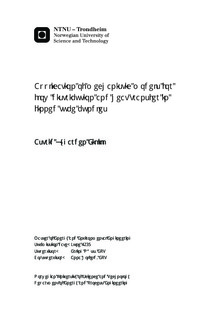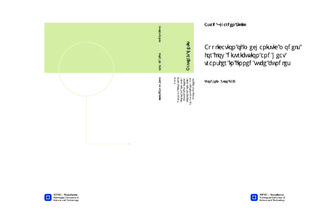| dc.description.abstract | The focus of this thesis was heat transfer and pressure drop in staggered tube bundles with solid and serrated fins. The first part of the work dealed with five prediction models, namely PFR's model (1976), Nir's model (1991), Ralston et al.'s HTFS1 model (1997), Chu and Ralston's HTFS2 model (1998) and McIlwain's HTFS3 model (2003). The models all had correlations for prediction of heat transfer and pressure drop, but only PFR and Nir had specific correlations for serrated fins. The correlations were tested for a multitude of tube bundle geometries - both solid finned and serrated finned - and Reynold's numbers, taken from a database containing hundreds of experiments by several investigators. The predicted results were compared to the measured values for heat transfer and pressure drop from the database. The comparison revealed that none of the models could accurately predict both heat transfer and pressure drop, for both solid fin and serrated fin tube bundles. Overall, the most accurate model was PFR, while the least accurate model was HTFS1. An attempt to improve the prediction accuracy of the models' correlations, by introducing corrections based on different geometric parameters, was carried out. This improvement succeeded for some correlations, but failed for others.
The correlations that were ultimately found to have the best prediction accuracy were:
\begin{itemize}
\item For heat transfer, solid fins: Modified Nir, with 76.2 \% of data predicted within $\pm$20 \% and 47.4 \% of data predicted within $\pm$10 \% AND modified HTFS2, with 79.8 \% of data predicted within $\pm$20 \% and 42.4 \% of data predicted within $\pm$10 \%.
\item For heat transfer, serrated fins: Modified HTFS3, with 74.1 \% of data predicted within $\pm$20 \% and 51.4 \% of data predicted within $\pm$10 \%.
\item For pressure drop, solid fins: Modified PFR, with 92.3 \% of data predicted within $\pm$30 \% and 67.0 \% of data predicted within $\pm$15 \% AND modified Nir, with 89.6 \% of data predicted within $\pm$30 \% and 71.2 \% of data predicted within $\pm$15 \%.
\item For pressure drop, serrated fins: Original PFR, with 64.6 \% of data predicted within $\pm$30 \% and 40.2 \% of data predicted within $\pm$15 \%.
\end{itemize}
The second part of the work was participation in pressure drop and heat transfer testing of one tube bundle geometry. The bundle consisted of 8 longitudinal tubes and 4 transversal tubes in a staggered layout, with a layout angle of 30$^\circ$. The tubes had an outer diameter of 31.75 mm. The fins were of the I-foot serrated type, with a total fin height of 18 mm, fin thickness 1 mm and fin pitch 3.62 mm. The pressure drop tests were done in the flow range $3.4\e{3}\leq Re \leq 4.1\e{4}$. The heat transfer tests were done in the flow range $6.4\e{3}\leq Re \leq 3.4\e{4}$ with inlet air temperature around 120-130$^\circ$C. The results of the testing showed pressure drop and heat transfer values in a plausible range, but with very high pressure drop uncertainty for low Re. The experimental values were compared to values calculated with the five prediction models. The measured pressure drop and heat transfer were found to best agree with the predictions of Nir and PFR, respectively. | |

